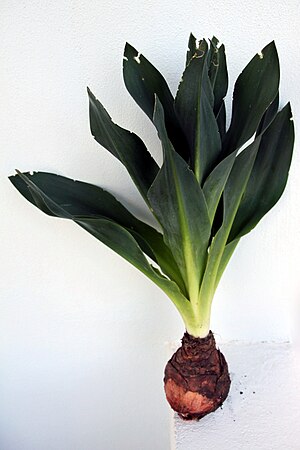Note: This is a project under development. The articles on this wiki are just being initiated and broadly incomplete. You can Help creating new pages.
Drimia maritima - Red squill
Drimia maritima or Red squill(syn. Urginea maritima) is a species of flowering plant in the family Asparagaceae, subfamily Scilloideae (formerly the family Hyacinthaceae). This species is known by several common names, including squill, sea squill, sea onion, and maritime squill.[1] It may also be called red squill, particularly a form which produces red-tinged flowers instead of white. It is native to southern Europe, western Asia, and northern Africa.
Description
This plant grows from a large bulb which can be up to 20 cm (7.9 in) wide and weigh 1 kg (2.2 lb). Several bulbs may grow in a clump and are usually just beneath the surface of the soil. In the spring, each bulb produces a rosette of about ten leaves each up to a meter long. They are dark green in color and leathery in texture. They die away by fall, when the bulb produces a tall, narrow raceme of flowers. This inflorescence can reach 1.5–2 m (4 ft 11 in–6 ft 7 in) in height. The flower is about 1.5 cm (0.59 in) wide and has six tepals each with a dark stripe down the middle. The tepals are white, with the exception of those on the red-flowered form. The fruit is a capsule up to 1.2 cm (0.47 in) long.
Uses
- The plant has been used as a poison and as a medicinal remedy. The main active compounds are cardiac glycosides, including unique bufadienolides such as glucoscillarene A, proscillaridine A, scillarene A, scilliglaucoside and scilliphaeoside.
- Its primary medicinal use was as a treatment for edema, then called dropsy, because of the diuretic properties of the cardiac glycosides.[2]
- The plant is also used as a laxative and an expectorant.[3]
- The tall inflorescences are used as cut flowers in floristry.
Common name
- English - Red squill
